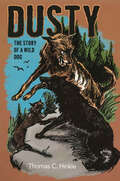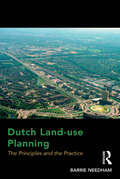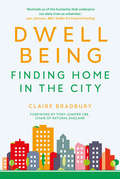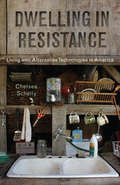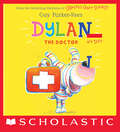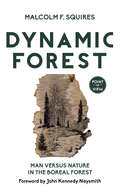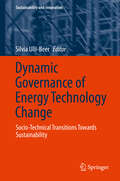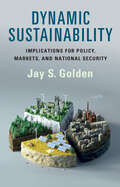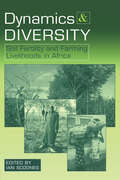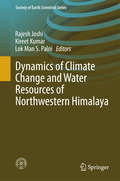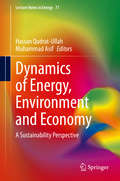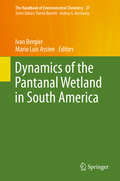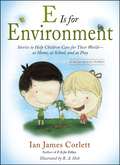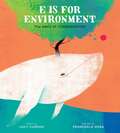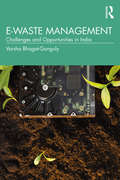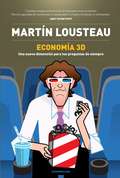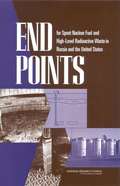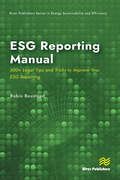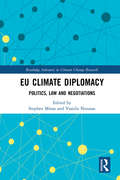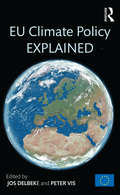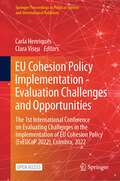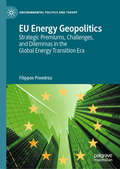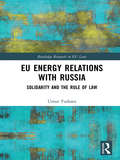- Table View
- List View
Dusty: The Story of a Wild Dog
by Thomas C. HinkleAt nine days of age a freak accident leaves Dusty, the wolfhound pup, separated from his mother. Old Gray, a she-wolf, adopts the lost pup after suffering her own tragedy. Old Gray raises Dusty and tries to instill in him the fear of man, but only partly succeeds. Besides the threat of man, the pair have numerous run-ins with two huge black wolves bent on destroying the mother and son. Young Matt Henderson then comes on the scene, and eventually catches and tames Dusty. The wolfhound proves himself to be invaluable to Matt. Finally, the black wolf and Dusty face off in one last fight. Join Dusty in his fight for survival.
Dutch Land-use Planning: The Principles and the Practice
by Barrie NeedhamDutch planning is widely known and admired for its ambitions and its achievements. This book provides, for the first time, a comprehensive description and analysis in English of its full range of policies and practices. It gives an up-to-date account of the principles - written and unwritten - behind the planning, and in addition shows how the practice sometimes ignores those principles in order to achieve better results. It describes the content of the policies, the measures taken to realise them, and the successes and failures. The book is not uncritical of Dutch land-use planning, but the author values its strengths and believes that planning in other countries could learn from them. These strengths arise in the continuing tension between the high ambitions of the Dutch planning, and the ingenuity and pragmatism exercised in order to realise those ambitions.
Dwellbeing: Finding Home in the City
by Tony Juniper Claire BradburyIn recent times, we have all questioned whether we feel truly nurtured by where we live. With 68 per cent of the world’s population predicted to live in cities by 2050, Dwellbeing is a call to stand firm on the seven pillars we cherish and so desperately need from our city homes: wilderness, nourishment, movement, connection, dwelling, imagination and love.Claire Bradbury is the ultimate urban nomad: born in the South African bush, she has spent her life working and living in cities across the globe. As an environmentalist, sustainability expert and wellbeing advocate, she explores how we can change the story of our city homes to be about dwelling, rootedness and joy, rather than a relentless rat race. She has spoken to everyone from city dwellers, street artists and planners to chefs, DJs and architects around the world to unearth the everyday actions that have the power to enhance our lives. Dwellbeing celebrates the leaders, creators and urban heroes who are rewriting the script on urban living, helping us to make the shift from ‘smart’ to ‘lovable’ cities.This beautiful book shows that, when it comes to reimagining our urban futures, everyone has a voice.
Dwelling in Resistance: Living with Alternative Technologies in America
by Chelsea SchellyMost Americans take for granted much of what is materially involved in the daily rituals of dwelling. In Dwelling in Resistance, Chelsea Schelly examines four alternative U.S. communities—“The Farm,” “Twin Oaks,” “Dancing Rabbit,” and “Earthships”—where electricity, water, heat, waste, food, and transportation practices differ markedly from those of the vast majority of Americans. Schelly portrays a wide range of residential living alternatives utilizing renewable, small-scale, de-centralized technologies. These technologies considerably change how individuals and communities interact with the material world, their natural environment, and one another. Using in depth interviews and compelling ethnographic observations, the book offers an insightful look at different communities’ practices and principles and their successful endeavors in sustainability and self-sufficiency.
Dylan the Doctor
by Guy Parker-ReesAn adorable new series featuring a fun doggy character all about occupations and imagination by Guy Parker-Rees, the bestselling illustrator of Giraffes Can't Dance!Dylan's on his way -- are you ready to play?Dylan the Doctor is the first story in a new series featuring an exuberant stripy dog who just loves to pretend and use his imagination. Created by beloved and bestselling illustrator Guy Parker-Rees, Dylan is a joyous new character who uses playing and fun to help toddlers explore and understand their world. Today Dylan is pretending to be a doctor. He dashes back and forth, looking after all of his friends. But who will look after poor, tired Doctor Dylan? All his friends, of course! Be sure to be on the lookout for Dylan's tiniest friend, Dotty Bug, on every page, as she encourages readers to join in with the story.
Dynamic Forest: Man Versus Nature in the Boreal Forest
by Malcolm F. Squires Dr John Kennedy NaysmithNearing the end of a lifetime in the boreal forest, a retired forester writes a passionate plea for rational, science-based forest management. The boreal forest is constantly changing, often dramatically. We like to picture it as a stable, balanced system. Really, it is anything but stable. The boreal forest is dynamic. For over sixty years, forester Malcolm F. Squires has seen mature forests within protected areas devastated by insects, moose, wind, and wildfire. While the forests often return from this destruction, they are never quite the same. A naturally balanced boreal forest is a human notion that does not match the reality of nature. If we don’t soon recognize and accept that reality and stop making irrational demands that a forest be “protected” from change or human management, we may be dooming them to disaster.
Dynamic Governance of Energy Technology Change
by Silvia Ulli-BeerFormulating effective responses to the global challenges of mitigating climate change and securing a sustainable energy future requires a clear understanding of the interdependent causalities between institutions, local decision making, strategic alliances and eco-innovations, as well as policies. It has been acknowledged that the linear "Manhattan project" model is not an adequate governance model for mastering the dynamic complexity of socio-technical transitions; therefore this book aims at advancing research on systematic transition management models. It offers qualitative and quantitative analyses of socio-technical transitions in road transportation and housing, bringing together tailored theorizing on sustainability transitions and applied system dynamics modeling. It highlights the interconnected causal feedbacks that are required to overcome the lock-in situation in road transportation and housing fueled by fossil energies. Showing which concerted actions and framework conditions are required in the transition phases in order to initiate and sustain socio-technical transition, it serves as a guide to model-based strategy making, policy design and analyses in support of sustainable futures.
Dynamics and Diversity: Soil Fertility and Farming Livelihoods in Africa
by Ian ScoonesSoils are critical to agriculture and, in turn, to food supply and livelihoods. Sustainable management of soils is crucial for a large proportion of the population of Africa. Contrary to many claims, soil fertility is improved and managed successfully by small-scale farmers there. Careful studies from widely different areas reveal how closely bound up soil management is with complex social, cultural and ecological factors - requiring a far more subtly tuned approach to development policy and practice. This work is a study of how the context of livelihood systems has to inform development policy and practice.
Dynamics of Climate Change and Water Resources of Northwestern Himalaya
by Rajesh Joshi Kireet Kumar Lok Man S. PalniThis book is about the Himalayan ranges as a source of fresh water supply and a perennial store house of ice, snow and permafrost as well as a vast repository of rich biodiversity, in the light of climate change. Special attention is given to the dynamics of snow and glaciers in the northwestern Himalayas, assessment of climate change patterns, and the consequences of changes and flow regime in order to understand the behaviour of climate change in the northwestern Himalayas. The outcome of melting glaciers are pro-glacial lakes. Their increasing size and potential danger of outbursts requires systematic study, particularly where there is the risk of impact on life and property. Furthermore, the changing trend of the hydrological cycle on a regional or local scale is another area of research which calls for the attention of geoscientists. To date there is a scarcity of reliable data meaning that a concerted effort is still required by all parties.
Dynamics of Energy, Environment and Economy: A Sustainability Perspective (Lecture Notes in Energy #77)
by Muhammad Asif Hassan Qudrat-UllahThe book addresses the vital and interwoven areas of energy, environment, and the economy within the field of sustainability research. Fundamental technical details, empirical data, and case studies taking into account local and international perspectives are included. Issues such as energy security, depleting fossil fuel reserves, global warming and climate change, as well as novel energy technologies are covered. The dynamic global response will be discussed from the perspective of policy, technology, and economics.Vital details in the form of text boxes, illustrations, graphs, tables and appendices are included. The book will serve as reference book for upper-level undergraduate and graduate students, researchers, academics, policy makers, NGOs and developmental sector professionals within the field.
Dynamics of the Pantanal Wetland in South America
by Ivan Bergier Mario Luis AssineThis book provides readers with in-depth insights into the changes in the Pantanal wetland from its formation to the actual and likely future states. It reveals that today's Pantanal is an evolutionary consequence of geological, ecological and, more recently, man-made events taking place at distinct space-time intervals. Topics include geotectonics and sun-earth interactions, which largely dictate the rate of drastic changes that eventually disrupt ecological stability and radically rebuild the regional landscape. Furthermore, the biota-climate system is discussed as a major driver reshaping the ecohydrology functioning of the landscape on an intermediate timescale. Also covered are major changes in the landscape ecohydrology and biodiversity due to recent land-use and climate changes induced by humankind in the Anthropocene. The ability to recognize how those temporal scales impact the Pantanal wetland provides the opportunity for wise management approaches and the sustainable development of the region.
E Is for Environment
by Ian James CorlettFrom the author of E IS FOR ETHICS, 26 stories with eco-friendly messages, accompanied by illustrations, discussion questions, and conservation tips.
E Is for Environment: The ABCs of Conservation
by Lucy CurranA is for Atmosphere, B is for Biodiversity, C is for Conservation, and so on in this delightful concept book that teaches young readers the ABCs of the natural world around us (and how to protect it).From jungles to recycling to wildlife preserves, each letter of the alphabet is represented by a word and image that reflects everything from the rainforest to the savannah to the depths of the ocean, as well as animal life across the continents. Readers will be inspired to join the movement to conserve species and find out how they can make a difference (because you're never too young to start saving the world!).
E-Waste Management: Challenges and Opportunities in India
by Varsha Bhagat-GangulyThis book offers an extensive review of e-waste management in India, the world’s third‑largest producer of waste from electrical and electronic equipment. With a focus on the evolution of legalframeworks in India and the world, it presents impacts and outcomes; challenges and opportunities; and management strategies and practices to deal with e-waste. First of its kind, the book examines relevant concepts and issues from across 15 disciplines and six areas of policy making and will serve as a comprehensive knowledge base on electronic waste in India. It links key themes to the global context of Sustainable Development Goals and explores the convergence with technological, infrastructural, and social initiatives in e-waste management. A range of topics are discussed, such as resource efficiency policies; circular economy; toxicity; technicalities and complexities of e-waste management including role of the informal sector and need for recognising social and human costs in policy making. The book deals with the role of statistics; legal trends and reforms; linkages with green Agenda 2030 and UN initiatives; implementation of Extended Producer Responsibility (EPR); environmental factors; business prospects; consequences on human health; Life Cycle Impact Assessment; the ‘six Rs’ (Responsible use, Repair, Refurbish, Recycle, Recover and Reuse); recycling practices and problems, material flow and informal sector in trade value chain; fostering partnership between formal-informal sectors; safe disposal; alternatives to landfilling; role of jurisprudence and regulatory bodies; and education and awareness. It also includes a survey of pan-India initiatives and trajectories of law-driven initiatives for effective e-waste management along with responses from industries and producers. Timely and essential, this volume will be useful to scholars and researchers of environment studies, digital waste management, waste management, development studies, public policy, political ecology, sustainable development, technology and manufacturing, design and instrumentation, environmental and international law, taxation, commerce, electronic industry, economics, business management, metallurgy, and engineering, labour studies, as well as to policymakers, nongovernmental organisations, and interested general readers.
ECONOMIA 3D (EBOOK)
by Martin LousteauLa economía te resulta aburrida, ajena, difícil y sin alma? No desesperes. También puede hacerte reír, aprender y hasta darte un poco de esperanza. Para eso no hace falta ponerse solemnes: alcanza con redescubrir con nuevos ojos sus enseñanzas más valiosas. En estas páginas, Martín Lousteau se mueve como un guía experto entre los tópicos más diversos e inesperados. El rol de los bancos y del sistema financiero, los esquemas mentales inconscientes que orientan nuestras decisiones, el desarrollo, la relación entre el dinero y la felicidad, la economía del sexo y del deporte, el consumo desorientado, la desigualdad, la crisis argentina y la debacle mundial, la ecología y el cambio climático son algunas de las estaciones de este recorrido repleto de realidad, humor y conocimiento.
EHI02 Paryavaran aur Anukulan Ka Aarambhik Svaroop - IGNOU
by IgnouThis units is divided into 4 chapters. It begins with how human had coordination with nature. Next chapters analysis the causes due to which some areas grew rapidly. In third and 4th chapter reader will get to know how cultural development took place in Indian sub continent.
END POINTS for Spent Nuclear Fuel and High-Level Radioactive Waste in Russia and the United States
by Committee on End Points for Spent Nuclear Fuel High-Level Radioactive Waste in Russia the United StatesEnd Points for spent Nuclear Fuel and High-Level Radioactive Waste in Russian and the United Statesprovides an analysis of the management of spent nuclear fuel and high-level radioactive waste in Russia and the United States, describing inventories, comparing approaches, and assessing the end-point options for storage and disposal of materials and wastes. The authoring committee finds that despite differences in philosophy about nuclear fuel cycles, Russia and the United States need similar kinds of facilities and face similar challenges, although in Russia many of the problems are worse and funding is less available. This book contains recommendations for immediate and near-term actions, for example, protecting and stabilizing materials that are security and safety hazards, actions for the longer term, such as developing more interim storage capacity and studying effects of deep injection, and areas for collaboration.
EPA Environmental Engineering Sourcebook
by J. Russell BouldingThe U.S. Environmental Protection Agency (U.S. EPA) publishes several series of documents that provide up-to-date information about environmental site assessment and remediation. The EPA Environmental Engineering Sourcebook includes papers and bulletins that focus on remediation of soil and groundwater, making them available in a convenient form.This book compiles thirty-five documents- written by recognized leaders - on major methods and promising new techniques for hazardous waste treatment and site remediation. Each chapter evaluates the type of contaminant and site characteristics needed to select a technology for use at hazardous waste sites.The EPA Environmental Engineering Sourcebook presents EPA documents in an easy-to-use, concise format. It contains numerous graphs, charts and figures that make it an important resource for those involved in environmental protection, site remediation, and site assessment. FeaturesContains chapters written by recognized leadersExamines major methods as well as assesses new techniques for hazardous waste treatment and site remediationPresents information in an easy-to-use, concise formatEvaluates each type of contaminant and site characteristics for selecting technology at hazardous waste sites
ESG Reporting Manual: 500+ Legal Tips and Tricks to Improve Your ESG Reporting (River Publishers Series in Energy Sustainability and Efficiency)
by Robin BousteadAre you struggling to navigate the complex landscape of ESG compliance? Do you fear falling victim to allegations of green or social-washing while also striving to deliver value for your shareholders? Look no further. Our ESG Reporting Manual offers 500+ legal tips and tricks, presented in a practical step-by-step format, to help your organization meet its reporting obligations and achieve success. Written by a seasoned business owner with decades of experience, this manual is your ultimate guide to navigating the complexities of ESG legislation with confidence. Don't let confusion hold you back any longer – let our manual guide you towards compliance and growth.
EU Climate Diplomacy: Politics, Law and Negotiations (Routledge Advances in Climate Change Research)
by Stephen Minas and Vassilis NtousasThe European Union has long played a leadership role in the global response to climate change, including the development and dissemination of climate-friendly technologies such as renewable energy. EU diplomacy has been a vital contributor to the development of international cooperation on climate change through the agreement of the United Nations Climate Convention, its Kyoto Protocol and, most recently, the Paris Agreement. In addition, the election of Donald Trump as President of the United States means that the EU contribution to climate diplomacy will become more important still, both in filling the leadership gap (together with other major economies) and in responding to any sabotage by the Trump administration. This book will extend knowledge of the EU as a key actor in climate diplomacy by bringing together leading practitioners and researchers in this field to take stock of the EU’s current role and emerging issues. Contributions will be grouped into three strands: 1) the interplay between EU climate diplomacy and internal EU politics; 2) how the EU’s legal order is a factor that determines, enables and constrains its climate diplomacy; and 3) the EU’s contribution to diplomacy concerning climate technology both under the Climate Convention and more broadly. Collectively, these contributions will chart the EU’s role at a critical time of transition and uncertainty in the international response to climate change. EU Climate Diplomacy: Politics, Law and Negotiations will be of great relevance to students, scholars and policymakers with an interest in international climate politics and policy, transnational environmental law and politics and EU studies more generally.
EU Climate Policy Explained
by Jos Delbeke Peter VisThe EU has been the region of the world where the most climate policies have been implemented, and where practical policy experimentation in the field of the environment and climate change has been taking place at a rapid pace over the last twenty-five years. This has led to considerable success in reducing pollution, decoupling emissions from economic growth and fostering global technological leadership. <P><P>The objective of the book is to explain the EU's climate policies in an accessible way, to demonstrate the step-by-step approach that has been used to develop these policies, and the ways in which they have been tested and further improved in the light of experience. The book shows that there is no single policy instrument that can bring down greenhouse gas emissions, but the challenge has been to put a jigsaw of policy instruments together that is coherent, delivers emissions reductions, and is cost-effective. The book differs from existing books by the fact it covers the EU's emissions trading system, the energy sector and other economic sectors, including their development in the context of international climate policy. <P><P>Set against the backdrop of the 2015 UN Climate Change conference in Paris, this accessible book will be of great relevance to students, scholars and policy makers alike.
EU Cohesion Policy Implementation - Evaluation Challenges and Opportunities: The 1st International Conference on Evaluating Challenges in the Implementation of EU Cohesion Policy (EvEUCoP 2022), Coimbra, 2022 (Springer Proceedings in Political Science and International Relations)
by Carla Henriques Clara ViseuThis open access book is the result of the 1st International Conference on Evaluating Challenges in the Implementation of EU Cohesion Policy (EvEUCoP 2022). It presents the recent findings, sparks discussion, and reveals new research paths addressing the use of novel methodologies and approaches to tackle the challenges and opportunities that are unveiled with the implementation of the EU cohesion policy. The authors cover a wide range of topics including the monitoring of data; the clearness of indicators in measuring the impact of interventions; novel evaluation methods, addressing the mid-term and terminal assessment; as well as case studies and applications on evaluations of the thematic objectives under the scrutiny of the cohesion policy, namely:• Research, technological development, and innovation; • Information and communication technologies;• Shift toward a low-carbon economy.During the 2014-2020 programmatic period, member states were required to undertake assessments to evaluate the efficacy, efficiency, and impact of each operational program. Such evaluations are generally concerned with the compliance of projects and activities with programmatic priorities, as well as with funds' absorption capacity and refer to ex-ante and ex-post assessments. Hence, this book proposes the use of novel methodologies addressing the mid-term and terminal assessments that enable performing the efficiency appraisal of the operational programs and that can support decision-makers in the selection of projects that should be awarded for funding.
EU Energy Geopolitics: Strategic Premiums, Challenges, and Dilemmas in the Global Energy Transition Era (Environmental Politics and Theory)
by Filippos ProedrouThe global energy transition will be a game-changer for global politics. The field of energy geopolitics hence is changing fast, providing challenges, opportunities and variable outcomes for states across the world. The academic scholarship on the geopolitics of renewables has expanded exponentially over the last decade focusing on winners vs losers, conflict vs cooperation and establishing initial expectations and general propositions regarding the outcomes of the global energy transition. Cases studies, however, have been far and few, and appear in book chapters or, more rarely, journal articles. Overall, there is a dearth of academic monographs examining in depth how specific actors in the global system approach new energy geopolitics, how they are impacted by the global energy transition, and how this links with their grand strategy. This short monograph aims to fill this gap by offering an up-to-date case study of EU energy geopolitics. Grounded upon the sub-field of energy geopolitics, it produces a conceptual framework linking the global energy transition with EU grand strategy to assess how it impacts EU’s position in the global system, as well as the strategic gains, trade-offs and risks implicated. The book takes as its starting point and reviews systematically the main assumptions of the geopolitics of the global energy transition literature and the EU energy and climate policy that drives and shapes the EU energy transition. It subsequently focuses its attention on the impact of the EU energy transition on EU energy security, economic competitiveness and foreign policy/ power position and the potential it generates for more conflict or cooperation. The discussion is anchored in the different forms of power the EU operationalizes and showcases the strengths, limits and antinomies of the EU power toolbox in EU energy geopolitics. The originality, significance and contribution of this monograph lies in the cross-fertilization of fossil divestment and clean energy geopolitics, energy and climate policy, energy transition and EU as a power scholarship, with an eye to provide a comprehensive, up-to-date account of new EU energy geopolitics. In all, this monograph dissects the prospects and geopolitical implications of the new energy geopolitics, and the foreign policy ramifications engendered by the global energy transition. This book is aimed at academics and students in the areas of International Relations, International Political Economy, European Studies, Geopolitics, and Energy Politics. It aspires, moreover, to become a reference point for the scholarship in the field of energy (geo)politics. Moreover, it will be of value to think-tanks and policy-makers working in the fields of foreign, energy and climate policy.
EU Energy Relations With Russia: Solidarity and the Rule of Law (Routledge Research in EU Law)
by Umut TurksenThis book provides a detailed analysis of the legal framework in which the energy trade between the European Union and the Russian Federation has been conducted. Using case studies of eight member states, it critically examines the EU’s ability and the duty of its Member States to conduct their external energy trade in accordance with the principle of solidarity. Providing a comprehensive analysis of the principle of solidarity as provided in the acquis communautaire of the EU, the book critically analyses the legal framework pertaining to EU-Russia energy trade to ascertain whether, and to what extent, it satisfies the requirements of the rule of law.
